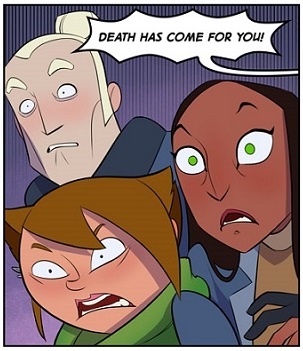Managing expectations is the basis for a fun roleplaying experience, it’s how we define the borders for our game.
Within these borders, however, the GM has free reign with setting and subverting expectations, and I would claim that a thoughtful use of this power is one of the most important tools in the GM’s toolbox.
This is a huge subject, with some huge questions (what should you subvert? when? and why?) but let’s for now just take a broad look at three general types of subversions, categorised by scale.
Immediate

Hey, my name’s Death, yes, I heard them all, my parents had some problems, can we please continue, thank you. I’m here about your taxes
DEATH HAS COME FOR YOU–.. Ahhh no she was talking about the body. This is the “cheapest” way to instil some emotion into the players, but it can be quite effective. Bogovia is the Land of the dark and gloomy, and the heroes are deep within an untamed forest – Nadav wants to keep the players on their toes, make them feel unsafe. Having a sudden death threat jump-scare is a simple way to do so, and anyway, he was wondering how to present this Bogovian woman… He needed some distinguishing feature for this NPC, and this entrance also gave him the inspiration to make her very melodramatic going forward.
This is an example of a GM immediately setting an expectation and subverting it a second later, but immediate subversions usually rely on the GM noticing an existing expectation, catching it, and using it to channel the players’ motivation or to enhance the atmosphere he’s aiming for (or his Agenda, in Dungeon World terms).
Let’s say we’re starting an action scene, and everyone draws cards. The big bad gets a Joker – which not only means she can act whenever she wants, she’s also going to get a +2 on her check, and +2 damage! That’s just how Jokers work in Savage Worlds. This draw sets some expectations, of course – the players are expecting to get hit hard this turn. The GM didn’t plan for this, but now that this expectation is in place, he might be able to use it by subverting it.
Imagine the players’ surprise, and dread, when the big bad uses her turn not to shoot the heroes with her machine gun, but instead, to activate the Infernal Machine behind her – which requires no roll. Seems like a waste of a Joker! So if she could have shot us with tons of bonuses, but instead decided to activate the machine… we realise that the Machine is even more dangerous than her drawing a Joker. This can be a useful way for the GM to divert the players’ attention to the Machine, which might actually be the real danger, something the players haven’t realised yet. He’s giving them a subtle clue that creates new motivations for them.
Adventure
This is the level in which most pre-planned subversions are made. “The princess was the one who kidnapped the dragon“ is one example – taking classic fantasy tropes that we all expected to see, and turning them around. Twists such as these tend to be used as a quick-and-dirty justification for a plot, which can be nice, but there are other things you can do when you set and subvert, to serve an already existing plot.
What’s the deal with the werewolf? I mean, wolf-beast; although, as next week’s page will show, there are enough signs of werewolf-ness to make the players think they’re dealing with a werewolf. Which makes them suspicious. Nadav never said “werewolf” – He wants the players to reach this conclusion by themselves, for a reason that will only be revealed in a few weeks, at which time it’ll help him reinforce the identity of the big bad, the themes of Bogovia, and the role of Crystals in the world and the campaign.
Campaign
The most effective, and probably hardest to set, are expectations that are made at the start of the campaign – within the borders, but not a declared part of the borders. When these expectations are eventually revealed to have been “false”, when the players realise the subversion, it usually adds a whole new layer to the entire campaign, especially if the GM was doing his homework since day 1.
However (and as some of you may have already noticed), when discussing these matters the difference between “players” and “readers” is quite subtle; and we’ll leave it at that.



